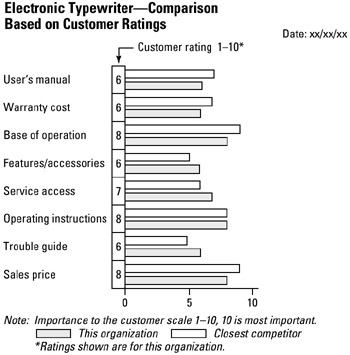Tool 181: Snake Chart
| AKA | N/A |
| Classification | Analyzing/Trending (AT) |
Tool description
The snake chart provides a quick comparison of products and services across attributes or product/service characteristics previously determined to be important to the customer on the basis of customer ratings. These results identify gaps in performance and therefore point to attributes that require improvement action.
Typical application
-
To compare customer-provided attribute ratings for products/services.
-
To conduct a quick performance gap analysis by analyzing competitor's data.
Problem-solving phase
| → | Select and define problem or opportunity |
| → | Identify and analyze causes or potential change |
| → | Develop and plan possible solutions or change |
| Implement and evaluate solution or change | |
| → | Measure and report solution or change results |
| Recognize and reward team efforts |
Typically used by
| 2 | Research/statistics |
| Creativity/innovation | |
| Engineering | |
| Project management | |
| Manufacturing | |
| 3 | Marketing/sales |
| Administration/documentation | |
| Servicing/support | |
| 1 | Customer/quality metrics |
| Change management |
before
-
Data Collection Strategy
-
Benchmarking
-
Nominal Prioritization
-
Attribute Listing
-
Cluster Analysis
after
-
Customer Satisfaction Analysis (CSA)
-
Customer-First-Questions (CFQ)
-
Information Needs Analysis
-
Problem Selection Matrix
-
Action Plan
Notes and key points
-
Customer rating scale should be 1–10, 10 being most important.
-
Do not rate more than 10 attributes of product or service at a time.
Step-by-step procedure
-
STEP 1 Collect benchmark data on competitor's product or service to be compared and analyzed. See example Electronic Typewriter—Comparison Based on Customer Ratings.
-
STEP 2 Develop a snake chart frame and scale according to rating scale.
-
STEP 3 Draw horizontal bars to represent competitor's and your organization's customer ratings for the selected product or service attributes.
-
STEP 4 Check all plotted information and date the chart.
Example of tool application

EAN: 2147483647
Pages: 326